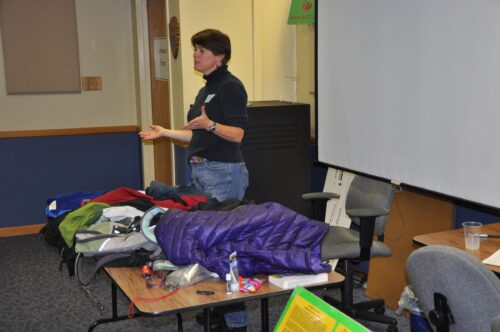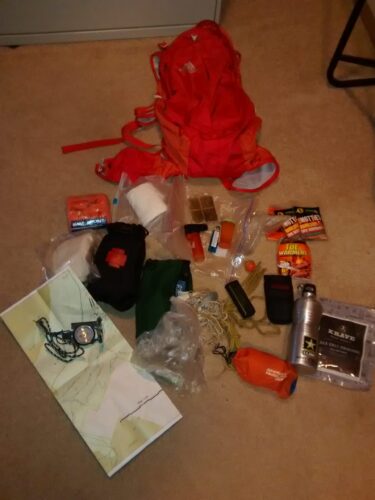
I. Dressing For Cross-Country Skiing
There are two good reasons to pay attention to what you wear for this highly aerobic activity: preventing hypothermia and comfort. You will usually be on the trail for the day (4-6 hours). Since you are in a mountainous area, there may be severe changes in weather (temperature and precipitation). You must also consider your own comfort level when exercising. Do you over-heat easily? Does your body not heat well? When you are engaged in vigorous activities such as cross-country skiing, your body generates heat and moisture. If you are overdressed, you will overheat and perspire. Excessive perspiration will rapidly cool your body when you stop to rest. You need "spare" clothing to prevent hypothermia.
Find out what the expected weather conditions will be before you leave for the day. You may not need long underwear, since it is difficult to remove on the trail, if the forecast is predicting temperatures that are above 20 degrees. The more you ski, the better you will know what is most comfortable for you. Clothes should be loose enough to allow for easy movement.
To avoid overheating, make small adjustments as you ski. For example, un-zip your wind-breaker or unbutton your collar. Put on that extra layer when you stop to rest. The following guidelines will help you make clothing choices so that you will be safe and comfortable to enjoy this wonderful activity. Two medium or thin layers (depending on weather) are better than one thick layer; the operative word is "layers".
Inner Layer
- Long underwear serves both as an insulating layer and to wick away perspiration.
- Short undies, boxers or briefs, sports bra.
- Turtlenecks that zip open at the neck allow you to make adjustments for comfort.
Fabrics:
- Best: Capeline, Polypropylene, (Thermax is good but very warm)
- Good: Wool, Wool Blend, Acrylic, Silk
- Poor: Cotton(holds moisture), nylon/lycra (doesn’t breath)
Middle Layer
- Jacket
- Vest
- Pants (loose around knees)
Fabrics:
- Best: Polartec
- Good: Wool
- Poor: Cotton
Outer Layer
- Should be waterproof, breathable to let body heat and moisture escape, wind resistant
- Jacket should have pit-zips (under arm venting zippers) or other ventilation flaps and a hood so there is continuous coverage of your neck area
- Windbreaker pants – large enough to fit over your pants so you may move freely
- Carry a light weight jacket that is just a wind-breaker, to use for that purpose only, if it is not precipitating. Jackets that are waterproof tend to be warm, and can overheat.
Fabrics: Gortex, Triple-point ceramic coated nylon, or any of the miracle fibers.
Head
- Hat that will cover your ears. Balaclavas work well since they also cover your face
- Ear muffs or headband, Scarf and Sunglasses
Hands
- First Layer – thin liners to keep fingers warm when Mittens/ gloves are removed to adjust equipment, eat, pit stop etc. Fabric: nylon, silk, polypropylene
- Second Layer - Mittens/warm gloves. Mittens are more effective for keeping fingers warm. Fabric: wool, Polartec
- Shell - Nylon or Gortex for water and wind resistance.
Feet
- Thin liner socks help prevent blisters and wick away moisture. Fabric: Olefin, thin wool, polypropylene or silk are good.
- Wool socks as the outer layer.
- Gaiters - keep you lower legs warm and snow out of your boot tops
II. Essential Gear
- Skis, boots, poles
- Sunscreen, (lip) chapstick
- First aid kit – incl.
- Blister pads and moleskin
- Trail food – for lunch and snacks, that won’t freeze
- Baggies in which to pack food
- Water bottles or "camel back" type receptacle
- Day pack (or large Fanny pack) to carry "stuff"
- Toilet paper/plastic bag
- Flashlight, Trail map, compass, whistle
III. OTHER TRAIL ITEMS
- Mylar blanket
- Bandanna – has multiple uses
- Plastic scraper – to remove "clumping" from skis
- Maxi glide – to prevent snow clumping on skis
- Sit-upon – to sit on for lunch or other stops. The ground will be wet! (hopefully). Can be a light piece of foam or heavy plastic – tush size, or larger.
- Animal Track Guide book

IV. ITEMS FOR NON SKI TIME
- Heavy/warm jacket
- Hiking boots to wear for walking around in the snow (or hiking if there is no snow)
- Snow shoes
- Ice skates (if there is a flat, frozen area in the vicinity)
- Bathing suit (if there is a pool or hot tub etc)
- Musical instruments
- Games, and other forms of group entertainment
V. DON’T FORGETS
- Extra shoe (boot) laces
- Toiletries, towel, soap, shampoo, medications, vitamins.
- Phone numbers in case of emergencies
- Emergency medical information
- Sleeping bag/sheet and blanket if necessary
VI. FOR YOUR CAR
- Ice scrapper, Shovel, Kitty Litter or sand, Chains or good snow tires
- Blankets, Flashlight, Anti-freeze
